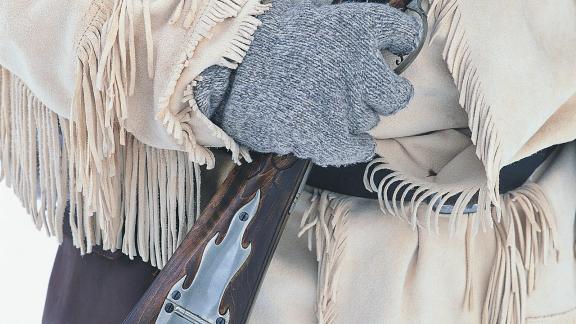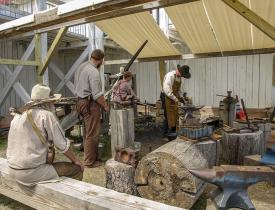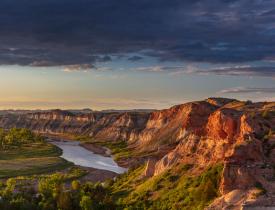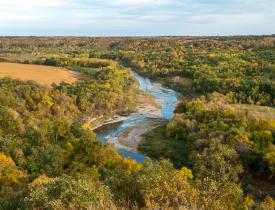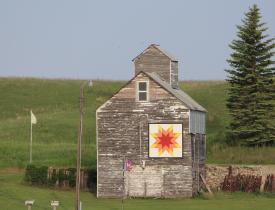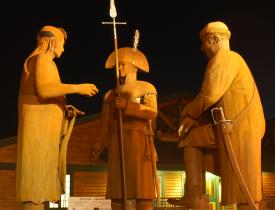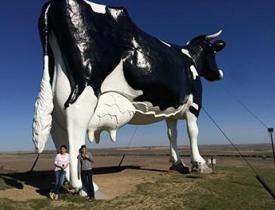Lewis and Clark
Everything You Want to Know about the Lewis and Clark Expedition
The Lewis and Clark Expedition, also known as the Corps of Discovery, made its way through North Dakota twice between 1804 and 1806. It became an adventure that helped shape the country, as the journey through the Louisiana Purchase from St. Louis to the Pacific Ocean and back opened the door for continued exploration and, ultimately settlement, of the previously unknown part of the nation. Read on for details about the journey.
Click here for more fun facts and a trivia quiz to test your knowledge
Louisiana Purchase
- When purchased from French Emperor Napoleon Bonaparte in 1803, it more than doubled the size of the United States.
- The US originally sought to purchase only the port city of New Orleans from France.
- Purchased for $15 million, it proved to be one of the greatest land deals in history.
Purpose of the Expedition
- A primary goal was to establish American claims to trans-Mississippi West.
- An important goal was the scientific study of flora and fauna, cultures and geography.
- Finding a water route through North America to the Pacific Ocean was a primary concern.
Compensation for the Corps of Discovery
- Lewis and Clark received 1,600 acres of land each, with $40 and $30 a month respectively.
- Lewis was named Governor of Louisiana and Clark the Superintendent of Indian Affairs for the same territory.
- Enlisted men received 320 acres each, with monthly payment of $8 for sergeants, $7 for corporals, and $5 for privates.
- Despite his impressive contributions, York, Clark’s slave, is not given any compensation, or his freedom.
- Toussaint Charbonneau, Sakakawea’s husband, was a French Canadian trader and hired for his interpretation skills. Although he was not held in particularly high regard by neither Lewis nor Clark, he was handsomely rewarded. Despite her contributions to the expedition, Sakakawea, as a woman, did not receive any separate compensation.
Miles Traveled Per Day
- On the trip north to the Mandan villages, the expedition averaged seven to 10 miles per day.
- On the trip back from the Mandan villages, the expedition made approximately 30 miles a day.
- Greatest distance traveled in a day was more than 50 miles, going downstream.
Navigation Skills
- Lewis trained under Andrew Ellicott, one of the top navigational experts in the US.
- The expedition made extensive use of the sextant, quadrant and other navigational devices to determine its position.
- Compasses were used to find and determine the magnetic north and differentiate between true north.
Keelboat
- Meriwether Lewis had a specially made 55-foot keelboat constructed for the voyage up the Missouri River.
- 55 feet in length with a reinforced hull, it was intended to survive water hazards - such as tree limbs and sandbars.
- Shares similarities with boats of Spanish design in the late 18th century.
Pirogue
- Lewis often used the terms “canoe” and “pirogue” interchangeably.
- The first pirogues Lewis purchased for the expedition leaked badly and caused the loss of supplies.
- Because they could unexpectedly tip, pirogues were sometimes bound together to increase stability.
Bull Boat
- A circular bison-skin covered boat used by the Mandan and Hidatsa on the Missouri River and its tributaries.
- Proved a remarkably stable boat in rough water and high winds, as William Clark discovered on the Yellowstone River.
- The bison-skin covered willow frame boats were strong enough to hold two or three people.
Fort Mandan
- Lewis and Clark’s 1804-1805 winter headquarters was located across from the Knife and Missouri river confluence.
- The fort had two rows of huts placed at an angle, with a palisade facing the river, sentry posts and small swivel cannon.
- The walls were 18 feet high and meant to, if need be, hold off an attack.
- A reproduction of the fort lies just west of Washburn.
Trade Items
- Tribes on the upper Missouri particularly valued blue-colored beads.
- Trade items included tobacco, thimbles, scissors, arm bands, silk, vermillion and knives.
- Emphasis on the trade and gift items was more on the visually attractive than the utilitarian.
- Beads remained a standard trade item until the 1850s, when the fur trade declined.
Food
- Most often expedition members consumed elk and bison as a matter of preference, although they supplemented their diet with other animals as well.
- As a result of extreme physical exertion, each person ate upwards of 6-7 pounds of meat a day, the equivalent of 24-28 hamburgers.
- The Corps’ diet was supplemented with vegetables, berries, and pemmican.
Medical Treatments
- ”Thunderclappers,” powerful laxatives invented by Philadelphia physician Benjamin Rush, was used with “regularity.”
- Bleeding of those ill was a common, if misguided, method of cure.
- Mercury was used for a number of ailments, though its toxic effects were not fully known at the time.
Common Medical Problems
- The most common medical problems were frostbite and syphilis.
- Common ailments on the trip were malaria, dysentery and rheumatism.
- ”Sore eyes” was also a common complaint, thought to be caused by blowing sand and/or the reflection of sunlight off of the water.
Moccasins
- Due to the limitations of their own footwear, moccasins were worn by all in the expedition after time spent at Mandan and Hidatsa villages.
- The moccasins had to be replaced every few days as a result of long walks on rough terrain.
- Moccasins, of course, had no arch support, but did not need it because of the soft soles’ ability to conform to the land.
Toe Ball
- Mandan and Hidatsa children played toe ball, a version of modern hacky-sack.
- The bird motif was of an old Hidatsa design.
- The Deerskin ball is stuffed with buffalo hair and decorated with porcupine quills.
New Species
- The expedition discovered and catalogued 178 new plants and 122 new species and subspecies of animals.
- Among the animals catalogued were big horn sheep, mule deer, grizzly bear, prairie dogs and pronghorn antelope.
- Botanists named some of the new plants discovered in honor of Lewis and Clark, such as Lewisia rediviva (bitterroot) and Clarkia pulchella (ragged robin).
Grizzly Bears
- Prairie grizzlies were referred to as “white” or “yellow” bears.
- Undoubtedly, the grizzly left the greatest impression of all of the animals seen and catalogued.
- Members of the expedition killed a grizzly bear south of Bismarck.
Cottonwoods
- Cottonwoods made a great impression on the expedition for their size, ease of use and strength.
- Cottonwoods were used in the construction of boats such as pirogues and dugouts.
- Fort Mandan, winter home of the Corps of Discovery, like Mandan earth lodges, boasted cottonwood construction.
Fossils
- One of the assigned duties of the Corps of Discovery was to record and obtain fossil remains.
- A 60-million-year-old petrified wood sample found near Fort Mandan was sent back to Thomas Jefferson.
- Native peoples collected fossils for hundreds of years, using them as ornaments and items of spiritual significance.
Notable Failures
- No water route to the Pacific Ocean was ever found, dashing hopes for opening Far Eastern trade via a shorter route.
- Licensing of fur traders proved unsuccessful and led to significant problems with Native peoples upstream.
- Indian policy also proved less than successful in the long run, as westward expansion provoked ongoing conflict until 1890.
- Conflict with the Blackfeet Nation on the return trip resulted in nearly 70 years of hostilities with the United States.
Lewis and Clark Expedition Timeline
1804
1804 Bibliography: A Lewis and Clark Chapbook, Lewis and Clark in North Dakota by Clay S. Jenkinson
October 14 - Expedition enters North Dakota. John Newman punished after court-martial
October 18 - Expedition reaches mouth of Cannonball River
October 20 - Expedition wounds its first grizzly bear just south of present-day Bismarck
October 21 - Mouth of Heart River
October 26 - Corps of Discovery arrives at Mandan villages
October 29 - First council with the Mandan and Hidatsa people
October 30 - Sheheke-shote comes to the Expedition's camp for the first time
November 2 - Clark selects site for Fort Mandan
November 4 - Toussaint Charbonneau introduces himself and offers his services as an interpreter
November 11 - Sakakawea comes to Fort Mandan for the first time
November 13 - Mandan Chief Black Cat brings Assiniboine delegation to Fort Mandan
November 25 - First Hidatsa visit to Fort Mandan
December 7 - Captain Lewis and men of the Expedition embark on a hunting trip at the invitation of Sheheke-shote
1805
1805 Bibliography: A Lewis and Clark Chapbook, Lewis and Clark in North Dakota by Clay S. Jenkinson
January 1 - Expedition members attend New Year's party at Mandan Villages
January 7 - Sheheke-shote draws a map of the country to the west for the captains
January 16 - Tensions between Mandan and Hidatsa surface in a conference at Fort Mandan
January 22 - Corps begins to dig its boats out of the Missouri River ice
February 9 - Captain Lewis orders court-martial of Private Howard for scaling the walls of Fort Mandan after the gate has been closed for the night
February 11 - Sakakawea gives birth to Jean Baptiste Charbonneau
February 15 - Lewis leads reprisal party to punish Sioux who attacked an Expedition hunting party
February 24 - The keelboat is finally extricated from the Missouri River ice
February 28 - Sixteen men begin to make canoes
March 9 - The Hidatsa Chief Le Borgne makes his first visit to the Fort
March 17 - Charbonneau apologizes for an earlier dispute and signs on with the Expedition
March 25 - Ice breaks up on the Missouri River
April 7 - Corps of Discovery leaves Fort Mandan
April 12 - Mouth of the Little Missouri River
April 16 - Clark reports the appearance of burning lignite coal veins
April 22 - Mouth of Little Muddy River
April 26 - Mouth of the Yellowstone River
April 27 - Expedition leaves North Dakota
1806
1806 Bibliography: A Lewis and Clark Chapbook, Lewis and Clark in North Dakota by Clay S. Jenkinson
August 3 - First of the return parties enters North Dakota
August 11 - Lewis accidentally shot by waterman and fiddler, Pierre Cruzatte
August 12 - All strands of the Expedition reunited near today's Sanish, ND
August 13 - Expedition meets Hancock & Dixon, first of the tidal wave of white trappers
August 14 - Arrive at Mandan and Hidatsa villages
August 16 - Shehek-shote agrees to visit President Jefferson in Washington D.C.
August 17 - Farewell to the Mandan and Hidatsa. William Clark visits the burned out shell of Fort Mandan
August 20 - The Expedition leaves North Dakota forever

